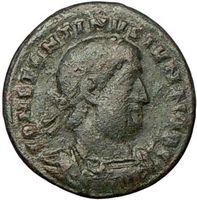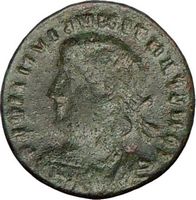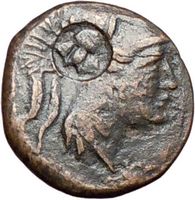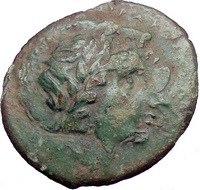Ancient Greek Roman Byzantine - Double-Strike
Countermark Brockage Error Coins for Sale Online
Buy certified ancient coins with coin errors, such as DOUBLE-STRIKE,
COUNTERMARK and BROCKAGE. Find out more about types of ancient coin
errors that are available for sale. There is also a large selection of
affordable ancient silver Roman coins available to buy. Get incredible
value with a LIFETIME GUARANTEE of AUTHENTICITY. Also every item
purchased here comes with a beautiuful custom-made certificate of
authenticity, complete with professional description, research,
professional photograph and historical synopsis, a $50-$100 value,
absolutely free, signed by world-renowned ancient coin expert, Ilya
Zlobin. A fun way to explore history, making a great gift, great for
coin collecting and investment!
 
Authentic Ancient Coin of:
Brockage error Coin of Constantine II 'Junior' -
Roman Emperor: 337-340 A.D. -
In coin collecting, brockage refers to a type of error coin in which
one side of the coin has both the normal image and a mirror image of the
opposite side impressed upon it.

Counter-mark Ancient Greek coin of Antigonos
Gonatas - Macedonian King: 277-239 B.C. with Head of Athena right,
in crested Corinthian helmet. Bee Countermark.
Countermarks on ancient coins were done for worn-out
coins to re-issue them back into circulation, as almost a "stamp" of
approval that it is legal tender.

Double-strike error Greek city of Syracuse in
Sicily
Bronze 25mm (5.91 grams) Struck under the Reign of Hiketas, 288-279
B.C.
This is an excellent example of this coin being struck
once, and then rotated slightly and struck again.
In coin collecting, brockage refers to a type of error coin in which
one side of the coin has both the normal image and a mirror image of the
opposite side impressed upon it.
Brockage errors are caused when an already minted coin sticks to the
coin die and impresses onto another coin. Brockages are relatively rare
among modern coins of industrialised countries where mints exercise a
strict production control and somewhat less rare among the modern coins
of some developing countries which operate their own mint (e.g. Nepal);
in good condition, coins with clear brockage are a collector's item and
can sell for substantial amounts of money.
One can distinguish between obverse and reverse brockages. Obverse
brockages occur when the previously struck coin was not ejected and gets
stuck to the lower die, and reverse brockages when the previously struck
coin remains stuck to the upper die.
In the production of
hammered coinage,
brockages were very common, although largely restricted to obverse
brockages, as the mint worker would likely notice if the coin was stuck
in the reverse anvil die. If the mint worker did notice the brockage,
they had the option of restriking it. There is no consensus among
numismatists concerning the existence of restruck brockages, as they
would appear similar to coins with heavily clashed dies.
The use of screw presses drastically reduced the amount of brockages
which escaped the mint from the mid 16th-century onwards, but as high
speed machinery became more common in the 19th century, more brockages
appear. It is known that some unscrupulous mint workers have created
brockages in the past simply in order to sell to coin collectors.
|